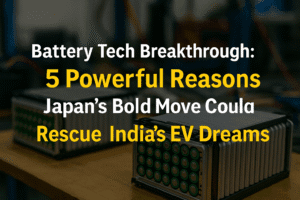Battery Tech Breakthrough: 5 Powerful Reasons Japan’s Bold Move Could Rescue India’s EV Dreams
Japan’s crucial technical mission arrives as India’s ambitious 30 GWh battery manufacturing push falters under the PLI scheme, with key players like Ola achieving only a fraction of targets. This intervention addresses the stark reality that setting up advanced, large-scale cell production requires deep expertise beyond capital – expertise Japan possesses through decades of R&D and precision manufacturing. The collaboration offers potential solutions to critical hurdles: mastering complex cell chemistry, establishing resilient supply chains, and achieving global competitiveness. Beyond meeting deadlines, it represents a strategic deepening of ties, providing India a trusted technological partner to reduce reliance on China and genuinely advance its “Atmanirbharta” (self-reliance) goals.
Success hinges on translating this support into adapted, scalable manufacturing processes and empowering Indian firms. Ultimately, affordable, domestically produced batteries are the bedrock for India’s entire electric vehicle ecosystem and adoption goals. This partnership is a vital test of whether international know-how can ignite India’s stalled battery revolution.

Battery Tech Breakthrough: 5 Powerful Reasons Japan’s Bold Move Could Rescue India’s EV Dreams
India’s ambitious drive to become a self-sufficient powerhouse in electric vehicle (EV) batteries faces a critical juncture. Against a backdrop of unfulfilled promises under the high-stakes Production-Linked Incentive (PLI) scheme for Advanced Chemistry Cell (ACC) batteries, a Japanese delegation arrives in early July. This isn’t just a routine visit; it’s a potential lifeline.
The Stumbling Blocks: Ambition vs. Reality
The PLI scheme’s stark reality check is impossible to ignore:
- Ola Cell Technologies: Installed a mere 1.4 GWh against a massive 20 GWh target.
- Reliance New Energy & Rajesh Exports: Facing significant hurdles, with timelines slipping. The message is clear: Setting up cutting-edge, giga-scale battery manufacturing is far more complex than setting targets. The hurdles are multi-faceted: mastering intricate cell chemistry and manufacturing processes, securing resilient supply chains for critical minerals, and achieving the economies of scale needed to compete globally.
Japan’s Offer: More Than Just Handshakes
Japan brings something India desperately needs: decades of hard-earned expertise in battery R&D and precision manufacturing. This delegation, blending government officials and industry veterans, signals a serious intent to provide tangible “technology support.” This likely means:
- Process Engineering: Sharing know-how on efficient, high-yield electrode production, cell assembly, and stringent quality control.
- Material Science Insights: Collaboration on optimizing electrolyte formulations, cathode/anode materials for cost and performance.
- Supply Chain Integration: Potential pathways for sourcing critical components or establishing joint ventures.
- Skilling & Standards: Assistance in developing a skilled workforce and implementing rigorous safety and performance standards.
Why This Collaboration Matters Now (Beyond PLI Deadlines):
- Strategic Depth: This builds on existing lithium-ion partnerships, moving towards a deeper, more operationally focused alliance. It recognizes that technology transfer, not just investment, is key to true self-sufficiency (“Atmanirbharta”).
- Geopolitical Hedge: For India, diversifying beyond China-centric battery tech is crucial. Japan offers a trusted, high-quality alternative partner. For Japan, India represents a vast future market and a strategic manufacturing hub.
- EV Ecosystem Catalyst: Affordable, reliable domestic batteries are the bedrock of India’s EV transition. Success here lowers EV costs, boosts adoption, and strengthens the entire domestic EV manufacturing chain – from automakers to component suppliers.
- Learning from Stumbles: The PLI scheme’s initial struggles highlight the gap between ambition and execution capability. Japanese collaboration offers a practical bridge, potentially accelerating the learning curve for Indian companies facing complex technological barriers.
The Real Test: From MoUs to Made-in-India Cells
The visit is a promising signal, but true success hinges on:
- Concrete Outcomes: Moving beyond memorandums to actionable joint projects, licensing agreements, or technology sharing pacts.
- Adaptation: Can Japanese processes and technologies be effectively adapted to the Indian manufacturing context and cost requirements?
- Sustainable Partnerships: Building relationships that foster long-term innovation, not just short-term fixes.
- Empowering Indian Firms: Ensuring the support genuinely uplifts the capabilities of Reliance, Ola, Rajesh Exports, and potentially others.
The Bottom Line:
Japan’s upcoming mission is more than diplomatic courtesy; it’s a recognition that India’s battery ambitions need a technological jumpstart. While the PLI scheme exposed the formidable challenges of scaling advanced battery manufacturing, this collaboration represents a vital opportunity to address the core technological and process gaps. If successful, it could be the catalyst that transforms India’s battery dreams from stalling on the drawing board to powering millions of EVs on the road. The world is watching to see if this partnership can deliver the spark India’s battery revolution needs.
You must be logged in to post a comment.